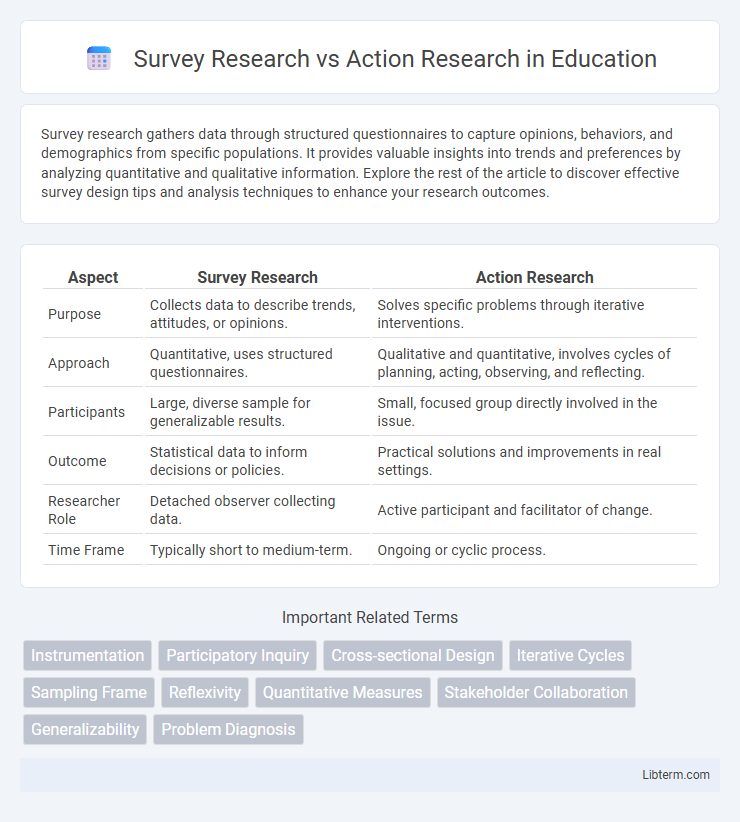Survey research gathers data through structured questionnaires to capture opinions, behaviors, and demographics from specific populations. It provides valuable insights into trends and preferences by analyzing quantitative and qualitative information. Explore the rest of the article to discover effective survey design tips and analysis techniques to enhance your research outcomes.
Table of Comparison
| Aspect | Survey Research | Action Research |
|---|---|---|
| Purpose | Collects data to describe trends, attitudes, or opinions. | Solves specific problems through iterative interventions. |
| Approach | Quantitative, uses structured questionnaires. | Qualitative and quantitative, involves cycles of planning, acting, observing, and reflecting. |
| Participants | Large, diverse sample for generalizable results. | Small, focused group directly involved in the issue. |
| Outcome | Statistical data to inform decisions or policies. | Practical solutions and improvements in real settings. |
| Researcher Role | Detached observer collecting data. | Active participant and facilitator of change. |
| Time Frame | Typically short to medium-term. | Ongoing or cyclic process. |
Introduction to Survey Research and Action Research
Survey Research systematically collects quantitative data to analyze trends, opinions, or behaviors across large populations using structured questionnaires and statistical methods. Action Research involves iterative, collaborative problem-solving within specific contexts, emphasizing practical change and participant involvement throughout its cyclical process of planning, acting, observing, and reflecting. Both methodologies serve distinct purposes: Survey Research provides broad, generalizable data insights, while Action Research targets localized improvements through direct engagement with stakeholders.
Defining Survey Research: Purpose and Methods
Survey research aims to systematically collect data from a predefined population using structured questionnaires or interviews to gather quantitative and qualitative insights. Its primary purpose is to identify patterns, attitudes, or behaviors within a large group, enabling statistical analysis and generalization of findings. Structured sampling methods, clear question design, and data analysis techniques like frequency distribution and correlation are essential to ensure validity and reliability in survey research.
Defining Action Research: Purpose and Methods
Action research is a participatory and iterative method aimed at solving practical problems through collaborative inquiry and reflection. It involves cycles of planning, acting, observing, and reflecting to implement change and improve practices within specific contexts. The purpose centers on generating actionable knowledge while actively engaging stakeholders to foster continuous learning and development.
Key Differences Between Survey Research and Action Research
Survey research primarily collects quantitative data from a large sample to identify trends, patterns, and generalizable insights, while action research involves iterative, collaborative problem-solving within a specific context to implement and evaluate changes. Survey research emphasizes statistical analysis and external validity, whereas action research focuses on practical outcomes, participant engagement, and continuous improvement cycles. The key difference lies in survey research's objective to describe phenomena versus action research's goal to drive actionable change through direct intervention.
Data Collection Techniques in Survey vs Action Research
Survey research primarily relies on structured questionnaires and standardized interviews to collect quantitative data from large, representative samples, ensuring statistical generalizability. Action research uses a blend of qualitative and quantitative data collection methods like participant observations, focus groups, and reflective journals, facilitating iterative feedback and practical problem-solving within specific contexts. The data collection in survey research emphasizes breadth and numerical analysis, while action research prioritizes depth, contextual understanding, and collaborative inquiry.
Advantages and Limitations of Survey Research
Survey research offers the advantage of collecting data from a large population efficiently, enabling statistical analysis and generalization of findings. Its limitations include reliance on self-reported data, which may introduce bias, and the lack of depth in understanding complex behaviors or motivations. Survey research is also less flexible in adapting to evolving research questions compared to more iterative methods like action research.
Advantages and Limitations of Action Research
Action research offers the advantage of promoting practical problem-solving through active collaboration between researchers and participants, leading to immediate improvements and increased stakeholder engagement. Its iterative nature allows for continuous feedback and adaptation, enhancing the relevance and applicability of findings in real-world contexts. Limitations include potential researcher bias, challenges in maintaining objectivity, and difficulties in generalizing results beyond the specific setting or group involved in the study.
Applications: When to Use Survey or Action Research
Survey research is most effective for collecting quantitative data from large populations to identify trends, opinions, and correlations in fields like market analysis, public health, and social sciences. Action research is ideal for addressing specific problems within organizations or communities by involving participants in iterative cycles of planning, acting, observing, and reflecting, commonly used in education, organizational development, and community empowerment. Choose survey research when seeking generalizable insights across diverse groups and action research when aiming to implement and evaluate practical solutions in real-time settings.
Examples of Survey Research and Action Research in Practice
Survey research often involves collecting quantitative data through structured questionnaires to study customer satisfaction or employee engagement across large populations. Action research is exemplified by educators iteratively testing new teaching strategies within classrooms to improve student learning outcomes in real-time. Both methodologies apply distinct approaches: survey research gathers broad, generalizable insights, while action research emphasizes collaborative problem-solving and continuous improvement in specific contexts.
Conclusion: Choosing the Right Research Approach
Selecting the appropriate research approach depends on the study's objectives and desired outcomes; survey research excels in gathering quantitative data for broad generalizations, while action research emphasizes iterative problem-solving and practical improvements within specific contexts. Researchers aiming for statistical analysis and population-level insights often prefer survey research, whereas those seeking participatory engagement and real-time interventions benefit from action research. Understanding the strengths and limitations of each method ensures the alignment of research goals with the most effective approach for valid, actionable results.
Survey Research Infographic

 libterm.com
libterm.com